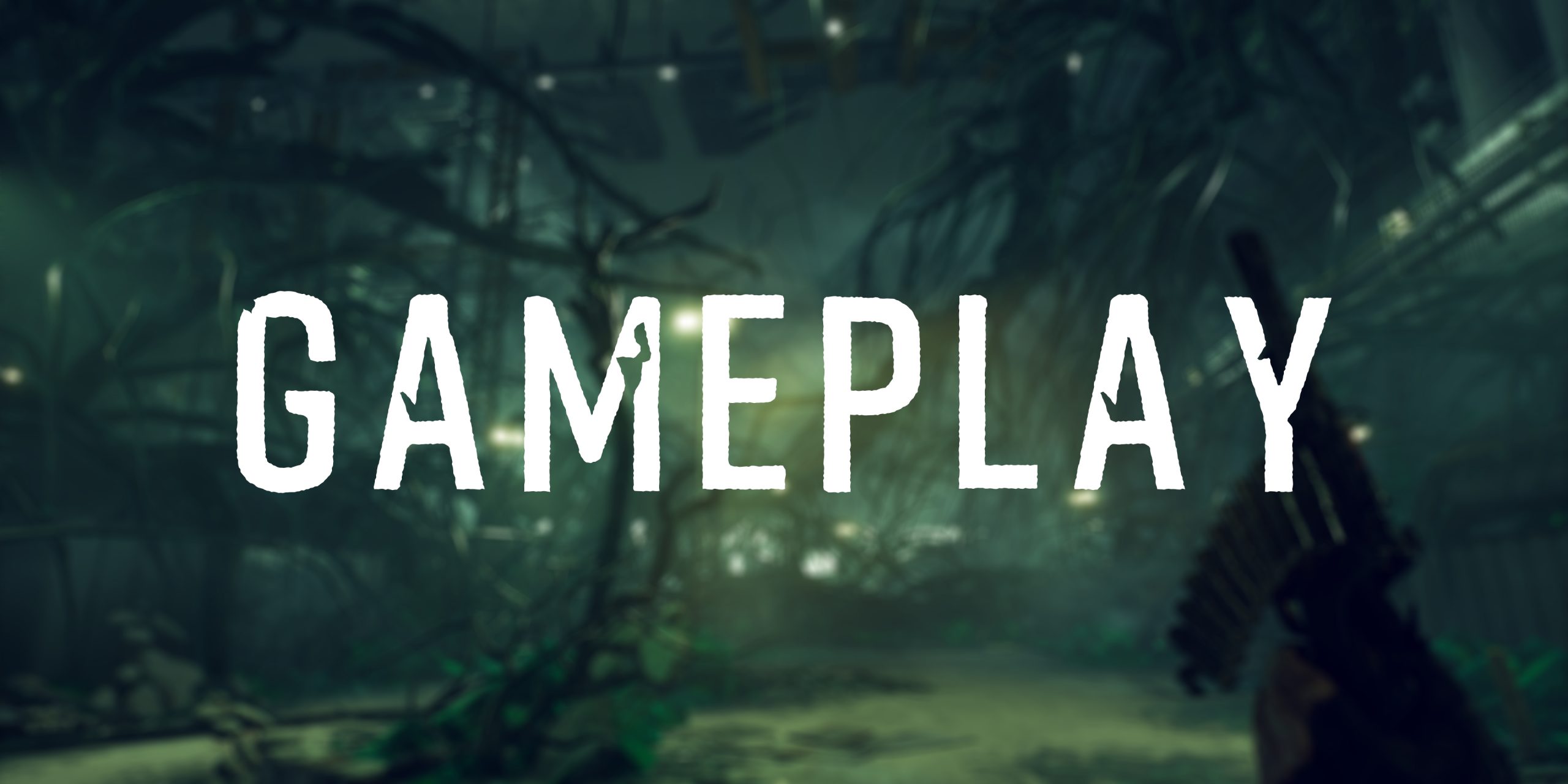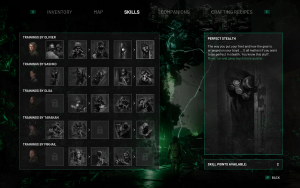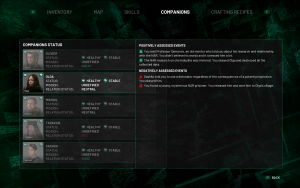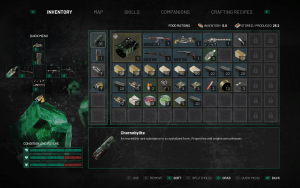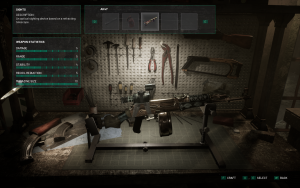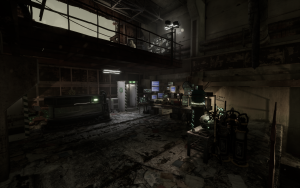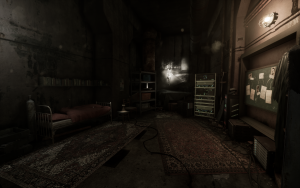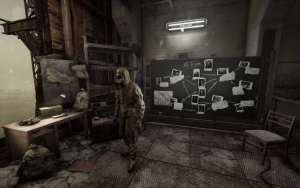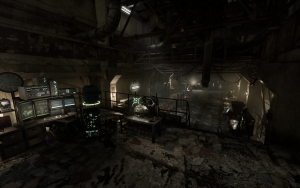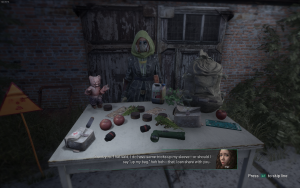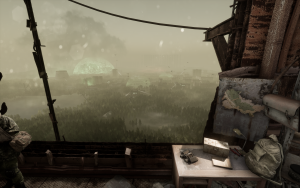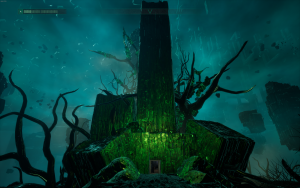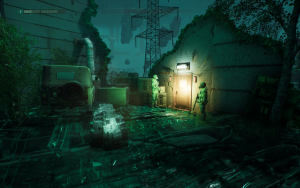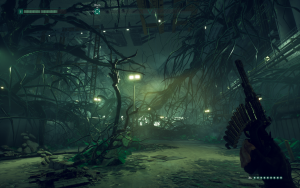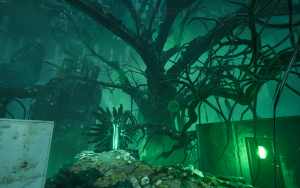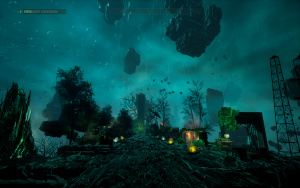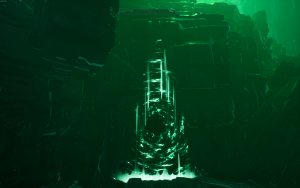While music, graphics and story are all important facets to a game, for some titles, gameplay remains king. In Chernobylite, the primary gameplay loop is perhaps one of its strongest suits – at least initially. The game is split up into days, with each day consisting of a similar repeated pattern: You wake up at your base, select what mission you wish to go on (out of a possible 5), assign the rest of the missions to your companions; go on the mission all the while gathering resources, picking up clues and experiencing the level; then returning to your base after a – hopefully – successful mission; feeding your team, creating weapons ammo and more and then going to sleep.
Tackling the gameplay loop one by one we’ll start with the missions. After the conclusion of the prologue, the player’s ultimate task is to infiltrate the NAR’s base, however in order to do so you must first be prepared. This is where the missions come in. You need companions, tools, intel and more – all of which can be found in the world.
This world is split up into 5 distinct areas. These open levels will be visited by you many times throughout the game’s 25-hour long campaign, each of which has its own sense of identity. Missions will vary from unimportant supply runs, to vital story missions. While the story missions will remain until you select them, the 5 or so other missions available to you will eventually be unavailable if you do not complete them within a certain number of days.
These timed-missions are of little importance however, and hold no effect on the story. With all that, you will assign different missions to different companions. Depending on their health status and equipment (both of which are affected by your direct actions), the companions will either succeed -bringing in new supplies – or fail: the consequences of which I will leave up to you to discover.
Going into these levels, players will encounter NAR soldiers; NPCs; scripted events (some of which can have effects later on based on your decisions); and other enemies. While you can take your time and spend as long as you want searching for supplies throughout the level, Chernobylite storms will begin to gather, with an extended stay seeing you attacked by a creature known only as the Black Stalker.
You can stave off this enemy and the storms by creating various equipment such as the Chernobylite Neutraliser and Wormhole Blocker. Throughout each journey into the exclusion zone, players must also make sure to manage their health, radiation levels and psyche – all of which can be affected by different events and interactions.
With all that in mind, the game offers plenty of different gameplay styles which one can approach each level with. Depending on what difficulty you are playing on, Chernobylite offers entirely different experiences. At the default level, the game starts as a stealth thriller title, with players needing to carefully manage their resources, ammo and more – all the while staying clear of enemies when possible, and trying to achieve the objective before the Black Stalker’s arrival.
Once you have a firm grasp on the game however, Chernobylite becomes an easy – and sometimes tedious – experience, with repetitive mission structures, exploitable AI and more ammo and health packs than you could ever need. This does allow the game to showcase its weapons, which have clearly had a lot of thought put into them. While the selection is limited, each weapon – from the revolver, to the AK-47 to the shotgun is completely customisable, affecting handling, fire rate and more. The level of customisation is deep enough to allow you to turn the AK into an effective sniper rifle.
The best part is that all of these changes are reflected in the gun models, with every single change making the weapon look different. This means that while there aren’t too many weapons to choose from, the number of gameplay styles afforded by these customisations is much greater than it initially appears. Furthermore, without spoiling anything, some of the late-game weapons are quite exciting and unique.
Going back to the difficulty however, while the default settings started off at a good level, but ultimately leads to your character feeling too overpowered – removing all sense of fear and making even the Black Stalker feel like a piece of cake – the difficulty settings are not simply “easy medium and hard” but in fact allow you to alter the difficulty on three different levels: Survival, Combat and Management.
These three settings can be tweaked individually, allowing you to craft a bespoke experience. If you want to have limited resources, but enemies aren’t particularly tough, you can do that. On the flip side, if you want combat to be a challenge, but the risk being worth it when it comes to the potential resources obtainable, you can do that too. The flexibility is commendable, allowing players to tweak the experience to their liking. It is just unfortunate that the settings the game defaults to ultimately do not reflect the survival horror/thriller aspect that Chernobylite was pitched as.
Upon completing a mission, you return to your base, feed your companions and upgrade your quarters using the resources found. There is a degree of base building and management in Chernobylite. While not as extensive as some dedicated games, the systems in Chernobylite will have you balancing a number of categories including electricity, companion comfort, radiation levels and more – each of which will affect other categories.
This means that you can build a nuclear generator in order to massively increase the amount of electricity available (used for all kinds of upgrade stations) at the cost of polluting the base. This system offers a fine balance that again, depending on your settings can make you either feel like you’re barely clinging on for survival, or can be quickly overcome and forgotten in a matter of hours.
Your base has much more to it than simply resource management. Igor can use his acquired skill points to learn upgrades from his companions. Each companion has their own specialty, allowing Igor to improve his skills during missions. While most of these upgrades serve as little more than stat boosts (increased damage, better stealth, etc…) some of the upgrades come with greater gameplay-altering effects – though nothing too crazy.
Even so, earning enough skill points to train with one of your companions is exciting every time for more than just gameplay reasons. Even when the stat simply allows for increased weapon damage, Igor will be taken to the training grounds by the respective companion as he completes a mini gameplay section, all the while learning more about his companions’ pasts, ideologies and more. The most amusing example of this came with the inventory upgrade, allowing you to carry more items. While some games would simply open up a number of spaces in your inventory menu, Chernobylite has you go and talk to Olga, as she gives you an in-depth tutorial on how to pack your bag more efficiently, all the while engaging in back-and-forth banter with Igor. These training missions are a small touch, but do a lot to make the world feel more grounded while also endearing you to each companion’s personality.
Finally, before going to bed, if you have managed to collect enough clues, Igor can use a purpose built VR headset to simulate past events, allowing him to uncover the secrets to Tatyana’s disappearance. While light in gameplay, merely seeing you walk around as you follow the events of the past, these sections are rich with trippy visuals, impossible architecture and a surreal sense of unease – teasing at some of the best parts of Chernobylite.
For those who are more spoiler conscious (at least with regards to gameplay spoilers), you may want to skip to the next section.
The one thing that makes Chernobylite stand out so much from other games is the functionality of the Chernobylite itself. This mysterious material holds within it many different functionalities. It allows you to use a portal generator, exting levels whenever you wish, however its true abilities are not realised until your first death. Despite its survival elements, you should not be afraid to die or make risky choices.
This is due to the fact that upon death, you are transported to a purgatory-like world, where all of your previous choices are put on display, showing the consequences of each action. In this space, you can then go to each choice – presented as a diorama – and change your past actions for the cost of some resources. While this means that replayability is somewhat light, the ability to change your choice upon death means that the developers allowed themselves much greater flexibility when it comes to cause and effect, making for a more dynamic set of consequences.
These areas – as with the simulation sequences – are filled with some of the game’s most unique and striking visuals, with branches representing the many different choices that you and Igor can make throughout the game. This mechanic really does help set Chernobylite apart from other survival games, showing that there is a lot more to the world of Chernobylite than first meets the eye. There’s a reason the game is called Chernobylite, and that is because its functionality really does allow the game its own distinct identity.
 KitGuru KitGuru.net – Tech News | Hardware News | Hardware Reviews | IOS | Mobile | Gaming | Graphics Cards
KitGuru KitGuru.net – Tech News | Hardware News | Hardware Reviews | IOS | Mobile | Gaming | Graphics Cards
